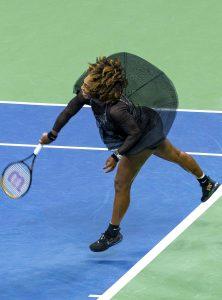We may earn money or products from the companies mentioned in this post.
The Significance of Understanding the Tennis Scoring System

When it comes to the game of tennis, understanding the scoring system is crucial for both players and spectators alike Whether you’re a seasoned player or an avid fan, having a solid grasp of how points are awarded and matches are won adds a whole new level of excitement and enjoyment to the game
Importance for Players
For players, knowing the ins and outs of tennis scoring is essential for strategizing and making split-second decisions on the court Each point carries significance and can determine the outcome of a match By understanding how points are earned, players can adapt their gameplay accordingly, utilizing different tactics to gain an advantage over their opponents
Furthermore, comprehending the scoring system allows players to keep track of their progress during a match Being aware of the current score helps them assess their performance, adjust their strategy if needed, and measure their chances of winning
Importance for Spectators and Fans
Tennis is not just about what happens on the court; it’s also about the experience as a spectator or fan Understanding the scoring system enables spectators to fully immerse themselves in the game They can follow along with each point won or lost, anticipate potential comebacks or upsets, and engage in lively discussions about the match
Moreover, being knowledgeable about tennis scoring allows fans to appreciate remarkable feats achieved by players It adds depth to their admiration by understanding how challenging it is to win consecutive games or achieve a decisive victory in tiebreaks This knowledge enhances their overall enjoyment when watching matches unfold before their eyes
Brief Overview of Tennis Terminology Origins

Tennis has its fair share of unique terminology that adds color and character to this beloved sport While it may seem like a jumble of strange words and phrases to newcomers, understanding the origins of tennis terminology can provide fascinating insights into the history and evolution of the game
The origins of tennis’ distinctive terms can be traced back to various sources For instance, the term “love,” which refers to zero points in tennis scoring, is believed to have originated from the French word for egg, “l’oeuf” This connection likely stems from the similarity in shape between an egg and the number zero
Another example is the word “deuce,” which signifies when both players are tied at 40-40 in a game It comes from the French phrase “à deux de jeu,” meaning “at two points from winning” Over time, this phrase evolved into its shortened form, becoming known as “deuce” in English tennis parlance
These linguistic peculiarities add charm and intrigue to the sport of tennis Understanding their origins not only deepens our appreciation for the game’s history but also serves as a reminder that tennis has transcended time and borders, leaving its mark on language itself
Understanding Tennis Scoring System

Basic Scoring Structure in Tennis Points, Games, and Sets
Tennis scoring can sometimes be confusing for those new to the sport However, once you grasp the basic structure, it becomes much easier to follow The scoring system in tennis is divided into three levels: points, games, and sets
Points System
In a tennis game, points are counted as 0, 15, 30, and 40 When a player wins a point, they move up the ladder from 0 to 15, then to 30 If they win another point after reaching 30, they reach “40” If both players reach “40,” it’s called “deuce”
Games and Tiebreaks Rules
A game is won when one player reaches four points or more with a two-point advantage over their opponent This means that if the score is deuce at 40-40 (or “deuce”), one of the players must win two consecutive points to win the game
In some cases where games are tied at six-all in a set (in regular matches), or at one-set-all in Grand Slam matches (like Wimbledon or Australian Open), a tiebreaker is played In a tiebreaker, players accumulate points individually until one player reaches seven points with a margin of two or more over their opponent
Sets and Match Win Conditions
A tennis match consists of multiple sets Typically men’s matches are best-of-five sets while women’s matches are best-of-three sets To win a set, a player must be the first to win six games with at least a two-game advantage over their opponent
If both players reach six games in a set, a tiebreaker is played to determine the winner of that particular set The player who wins the tiebreaker is awarded one additional game, resulting in a 7-6 score for that set
To win the match, a player must win the required number of sets For example, in men’s matches, a player must win three out of five sets to be victorious
Explanation of “30 Love” in Tennis

Definition
In tennis scoring, “30 Love” refers to the score when one player has won two points and their opponent has not yet scored any It signifies that the leading player is ahead by two points without conceding any to their opponent
Significance Within a Game
“30 Love” can be an important moment within a game as it reflects the momentum and dominance of one player over another It puts pressure on the trailing player to catch up and avoid falling further behind in terms of points
Furthermore, “30 Love” serves as an indicator of how well a player is performing at that particular moment It can boost confidence for the leading player while urging the trailing player to step up their game and mount a comeback
Origins of Tennis Scoring Terms: Love, Deuce, and Advantage

The History behind the word “Love”
Have you ever wondered why tennis players refer to a score of zero as “love”? The origin of this term is shrouded in mystery, with several theories attempting to explain its peculiar usage One theory suggests that “love” comes from the French word “l’oeuf,” which means egg In olden times, an egg was often used to represent zero on a scoreboard Another theory suggests that “love” could be derived from the phrase “to play for love,” meaning to play without any monetary stakes Regardless of its true origin, the term has become synonymous with a score of zero in tennis
Fascinatingly, the use of unique scoring terms like “love” is not exclusive to tennis Other sports such as cricket and baseball also have their own distinctive scoring systems Cricket uses terms like “duck” or “golden duck” to signify when a batsman gets out without scoring any runs, while baseball has phrases like “goose egg” or simply “zero” These diverse scoring terminologies add charm and character to each sport’s history and traditions
The idea behind “Deuce” in tennis
In tennis, when both players are tied at 40-40 (or three points each), it’s known as a “deuce” This term adds an element of suspense and excitement to the game as it signifies an important turning point when one player must win two consecutive points to secure victory in that particular game
The word “deuce” itself is believed to have originated from the Old French word for two, which is pronounced as “deus” This connection with the number two reflects its significance within the context of winning two consecutive points to break the tie Interestingly, the term “deuce” is also used in other sports such as table tennis and squash, where it represents a similar situation of a tied score
In-depth look at the term “Advantage”
During intense matches, when both players are tied at deuce (40-40), the term “advantage” comes into play It signifies that one player has won the next point after deuce and is now one step closer to winning the game The player with advantage only needs to win one more point to secure the game
The concept of advantage adds an extra layer of excitement and tension to tight matches, as it provides a clear indication of which player has taken control In some cases, this advantage can shift back and forth multiple times before a final winner emerges
The importance of advantage lies in its ability to dictate momentum within a match It puts pressure on both players, with one striving to maintain their advantage while the other fights to level the score back to deuce This back-and-forth battle for advantage showcases the strategic nature of tennis and highlights how critical each point becomes in determining the outcome of a game
Tennis Scoring Strategy And Tactics Related To “30 Love”

When the score reaches “30 Love” in a tennis match, the players’ mentality can be greatly influenced by various factors Whether leading or trailing by this score, both players must carefully consider their next moves and strategies to maximize their chances of success
Factors affecting players’ mentality at “30 Love”
1
Player leading by ’30-love’:
a Pressure management: A player who is leading by “30 Love” may experience pressure to maintain their advantage It is crucial for them to stay focused and composed, not letting overconfidence or complacency affect their performance
b Tactics to maintain or extend lead: To maintain or extend their lead, the leading player may employ various tactics such as playing more defensively, aiming for consistent shots, and avoiding unnecessary risks that could potentially give the opponent an opportunity to make a comeback
2
Player trailing by ’30-love’:
a How to make a comeback: For a player trailing by “30 Love,” making a comeback becomes essential They need to mentally regroup, analyze their opponent’s weaknesses, and strategize on how to turn the tide in their favor
b Ways to break opponent’s momentum: Breaking the opponent’s momentum is crucial for a player trailing behind in the score This can be achieved through aggressive shot-making, taking calculated risks at opportune moments, and capitalizing on any mistakes made by the leading player
Importance of mental strength in tennis scoring situations
In tennis scoring situations like “30 Love,” mental strength plays a vital role in determining a player’s performance and success on the court
1
Role of psychology in high-pressure situations:
Psychology plays a significant role in high-pressure situations like “30 Love” The ability to stay focused, maintain a positive mindset, and manage emotions can greatly impact a player’s performance Mental toughness helps players overcome challenges and make better decisions under pressure
2
Techniques used by professional players:
Professional players employ various techniques to enhance their mental strength during tennis scoring situations These include visualization exercises, positive self-talk, deep breathing techniques, and the ability to quickly adapt to changing circumstances on the court
Conclusion

In conclusion, “30 Love” is a phrase commonly used in tennis to describe the score when one player has won two points and their opponent has not yet scored This unique scoring system adds an element of suspense and excitement to the game, as players must strive to win four points to secure a game
Understanding the tennis scoring system is essential for anyone looking to fully appreciate and enjoy the sport By grasping the concept of “30 Love” and other score combinations, you can follow along with matches more easily and cheer on your favorite players with greater enthusiasm
Deepening Your Understanding of Tennis
If you’re interested in diving deeper into the world of tennis, there are countless resources available that can help you expand your knowledge Exploring the rules, history, and strategies behind this beloved sport will enhance your appreciation for its intricacies
-
Tennis Rules:
Familiarize yourself with the official rules of tennis, including various shot techniques, court dimensions, and code violations Understanding these rules will provide clarity during matches -
Tennis History:
Delve into the rich history of tennis, from its origins in medieval Europe to its evolution into a global phenomenon Learning about iconic players, historic tournaments, and memorable moments will deepen your connection to the sport -
Tennis Strategies:
Explore different strategies employed by professional players to gain an edge on the court From mastering powerful serves to executing well-placed shots, understanding strategic approaches can elevate your own gameplay
To further enhance your learning experience, consider watching live matches or attending local tournaments Engaging with fellow tennis enthusiasts through forums or social media communities can also foster discussions about tactics, player performances, and upcoming events
By immersing yourself in the world of tennis, you’ll not only gain a greater understanding of the sport but also develop a deeper appreciation for the skill, athleticism, and mental fortitude required to excel on the court
Useful Links

What Does Love Mean In Tennis?
Why Does ‘Love’ Mean ‘Zero’ in Tennis?
LOVE in Tennis: What it Means & Origin – YouTube
30-Love Tennis Kit
Tennis Scoring: Points, Sets & Games | Tennis Rules
Does Love Conquer All In Tennis?
Why Is Tennis Scored So Weirdly?
Why is Tennis Scored the Way it is? (Tennis Scoring History)
What does love mean in tennis?
Why do we call zero score in tennis called as ‘love’? Why …
Why Do They Say Love Instead of 0 in Tennis?
In tennis, does anybody know why the scoring goes 15 to 30 …
Love in tennis – Meaning, Use cases and Word’s origin
The Tennis Scoring System
How to Keep Score in Tennis
What is Love in Tennis? When Love is used? (Explained …
Why Is Zero Called Love In Tennis? (The Truth)
Tennis scoring, explained: A guide to understanding the …






